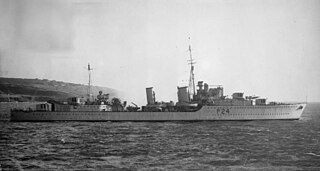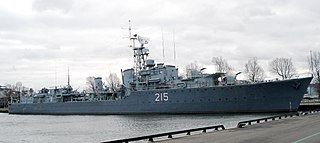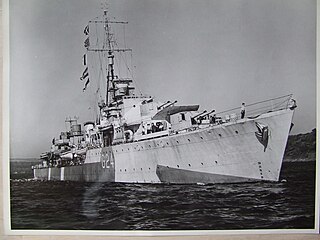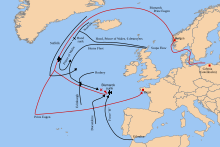
HMS Hyperion was an H-class destroyer built for the Royal Navy during the mid-1930s. During the Spanish Civil War of 1936–1939, the ship enforced the arms blockade imposed by Britain and France on both sides as part of the Mediterranean Fleet. During the first few months of World War II, Hyperion searched for German commerce raiders in the Atlantic Ocean and blockaded German merchant ships in neutral harbours until she returned to the British Isles in early 1940. The ship participated in the Norwegian Campaign before she was transferred back to the Mediterranean Fleet shortly afterwards. Hyperion participated in the Battle of Calabria and the Battle of Cape Spada in July 1940 while escorting the larger ships of the fleet. The ship covered several convoys to Malta before she struck a mine and was deliberately scuttled in December 1940.

HMS Maori was a Tribal-class destroyer named after the indigenous Māori people of New Zealand. She served with the United Kingdom Mediterranean Fleet during World War II until she was bombed and sunk by German aircraft while at Malta in 1942. Her wreck was later raised and scuttled outside the Grand Harbour. The wreck is now a dive site.

HMS Cossack was a Tribal-class destroyer named after the Cossack people of Ukrainian steppe. She became famous for the boarding of the German supply ship Altmark in Norwegian waters, and the associated rescue of sailors originally captured by the Admiral Graf Spee. She was torpedoed by the German submarine U-563 on 23 October 1941, and sank four days later.

HMS Afridi was one of 16 Tribal-class destroyers built for the Royal Navy shortly before the beginning of Second World War in 1939. Completed in 1938 the ship was initially assigned to the Mediterranean Fleet where she served as a flotilla leader. Afridi was briefly involved enforcing the arms blockade on the combatants in the Spanish Civil War. The ship returned home shortly after the start of the Second World War and was assigned convoy escort duties. She played an active role in the Norwegian Campaign of April–May 1940, escorting convoys to and from Norway. Afridi was sunk by German dive bombers on 3 May as she was escorting the evacuation convoy after the failure of the Namsos Campaign.

HMS Gurkha was a Tribal-class destroyer that saw active service in the Norway Campaign in 1940, where she was sunk.

The Tribal class, or Afridi class, were a class of destroyers built for the Royal Navy, Royal Canadian Navy and Royal Australian Navy that saw service in World War II. Originally conceived during design studies for a light fleet cruiser, the Tribals evolved into fast, powerful destroyers, with greater emphasis on guns over torpedoes than previous destroyers, in response to new designs by Japan, Italy, and Germany. The Tribals were well admired by their crews and the public when they were in service due to their power, often becoming symbols of prestige while in service.

HMS Zulu was a Tribal-class destroyer of the Royal Navy and the second ship to bear the name. Built in Glasgow by Alexander Stephen and Sons, her keel was laid down on 10 August 1936, she was launched on 23 September 1937 and commissioned on 7 September 1938.

HMS Mohawk was one of 16 Tribal-class destroyers built for the Royal Navy shortly before the beginning of Second World War in 1939. Completed in 1938 the ship was initially assigned to the Mediterranean Fleet. She was briefly involved enforcing the arms blockade on the combatants in the Spanish Civil War in early 1939. Mohawk returned home shortly after the start of the Second World War and was assigned convoy escort duties, during which she was damaged by German bombers. She played an active role in the Norwegian Campaign of April–May 1940, escorting convoys to and from Norway.

HMS Greyhound was a G-class destroyer built for the Royal Navy in the 1930s. Greyhound participated in the Norwegian Campaign in April 1940, the Dunkirk evacuation in May and the Battle of Dakar in September before being transferred to the Mediterranean Fleet in November. The ship generally escorted the larger ships of the Mediterranean Fleet as they protected convoys against attacks from the Italian Fleet. She sank two Italian submarines while escorting convoys herself in early 1941. Greyhound was sunk by German Junkers Ju 87 Stuka dive bombers north-west of Crete on 22 May 1941 as she escorted the battleships of the Mediterranean Fleet attempting to intercept the German sea-borne invasion forces destined for Crete.

HMS Foresight was one of nine F-class destroyers built for the Royal Navy during the 1930s. She was assigned to the Home Fleet upon completion. Unlike her sister ships, she does not appear to have been attached to the Mediterranean Fleet in 1935–36 during the Abyssinia Crisis, nor did she enforce the arms blockade imposed by Britain and France on both sides of the conflict the Spanish Civil War of 1936–1939. The ship escorted the larger ships of the fleet during the early stages of World War II and played a minor role in the Norwegian Campaign of 1940. Foresight was sent to Gibraltar in mid-1940 and formed part of Force H where she participated in the attack on Mers-el-Kébir and the Battle of Dakar. The ship escorted numerous convoys to Malta in 1941 and Arctic convoys during 1942. Later that year, Foresight participated in Operation Pedestal, another convoy to Malta. She was torpedoed by an Italian aircraft on 12 August and had to be scuttled the next day.

HMS Ashanti was a Tribal-class destroyer of the Royal Navy. Following the style of her sister ships she was named for an ethnic group, in this case the Ashanti people of the Gold Coast in West Africa. She served in the Second World War and was broken up in 1949. She was the first of two Royal Navy ships to bear the name Ashanti.

HMS Acasta was one of eight A-class destroyers built for the Royal Navy (RN) in the 1920s. The ship spent most of the 1930s assigned to the Mediterranean Fleet. During the early months of the Spanish Civil War of 1936–1939, Acasta spent considerable time in Spanish waters enforcing the arms blockade imposed by Britain and France on both sides of the conflict.

HMCS Huron was a Tribal-class destroyer that served in the Royal Canadian Navy in the Second World War and the Korean War. She was the first ship to bear this name, entering service in 1943. She was named for the Huron people. During the Second World War the vessel saw service in Operation Neptune in the Bay of Biscay and along the French coast in support of the invasion of Normandy and escorted convoys to the Soviet Union. Following the war, the ship was placed in reserve. The destroyer was activated in 1950 as a training ship, but with the onset of the Korean War, was modernized and deployed twice to Korea. Following the war, Huron reverted to a training ship and took part in Cold War-era North Atlantic Treaty Organization (NATO) naval exercises until being paid off for the final time in 1963 and broken up for scrap in 1965.

HMS Punjabi was a Tribal-class destroyer of the Royal Navy that saw service in the Second World War, being sunk in a collision with the battleship King George V. She has been the only ship of the Royal Navy to bear the name "Punjabi" which, in common with the other ships of the Tribal class, was named after various ethnic groups of the world, mainly those of the British Empire.

HMS Nubian was a Tribal-class destroyer of the Royal Navy that saw much distinguished service in World War II. She won 13 battle honours, a record only exceeded by one other ship, and matched by two others.

HMS Matabele was a Tribal-class destroyer of the Royal Navy that saw service in World War II, being sunk by a U-boat on 17 January 1942. She has been the only ship of the Royal Navy to bear the name Matabele, which in common with the other ships of the Tribal class, was named after an ethnic group of the British Empire. In this case, this was the Anglicisation of the Ndebele people of Zimbabwe.

HMS Tartar was a Tribal-class destroyer of the Royal Navy that saw service in most of the naval theatres of World War II. She had an eventful career, eventually receiving the nickname 'Lucky Tartar' due to her numerous escapes from dangerous situations. She was one of only four from the sixteen Royal Navy-operated Tribal-class destroyers to survive the war.

HMS Escapade was an E-class destroyer built for the Royal Navy in the early 1930s. Although assigned to the Home Fleet upon completion in 1934, the ship was attached to the Mediterranean Fleet in 1935–1936 during the Abyssinia Crisis. During the Spanish Civil War of 1936–1939 she spent considerable time in Spanish waters, enforcing the arms blockade imposed by Britain and France on both sides of the conflict. Escapade was assigned to convoy escort and anti-submarine patrol duties in the Western Approaches when World War II began in September 1939, but transferred back to the Home Fleet at the end of the year.

HMS Fearless was an F-class destroyer built for the Royal Navy during the 1930s. Although assigned to the Home Fleet upon completion, the ship was attached to the Mediterranean Fleet in 1935–36 during the Abyssinia Crisis. During the Spanish Civil War of 1936–1939, she spent time in Spanish waters, enforcing the arms blockade imposed by Britain and France on both sides of the conflict. Several months after the start of the war in September 1939, Fearless helped to sink one submarine and sank another one in 1940 during the Norwegian Campaign. She was sent to Gibraltar in mid-1940 and formed part of Force H where she participated in the attack on the Vichy French ships at Mers-el-Kébir and the bombardment of Genoa. Fearless helped to sink one final submarine in 1941 and escorted many Malta convoys in the Mediterranean before she was torpedoed by an Italian bomber and had to be scuttled on 23 July 1941.

HMS Forester was one of nine F-class destroyers built for the Royal Navy during the early 1930s. Although assigned to the Home Fleet upon completion, the ship was attached to the Mediterranean Fleet in 1935–36 during the Abyssinia Crisis. A few weeks after the start of World War II in September 1939, she helped to sink one German submarine and then participated in the Second Battle of Narvik during the Norwegian Campaign of 1940. Forester was sent to Gibraltar in mid-1940 and formed part of Force H where she participated in the attack on the Vichy French ships at Mers-el-Kébir and the Battle of Dakar between escorting the aircraft carriers of Force H as they flew off aircraft for Malta and covering convoys resupplying and reinforcing the island until late 1941. During this time the ship helped to sink another German submarine.






















